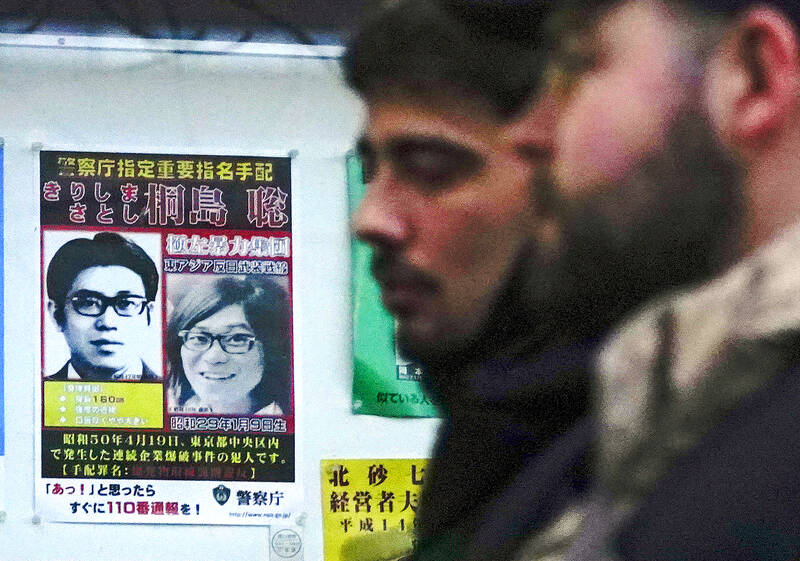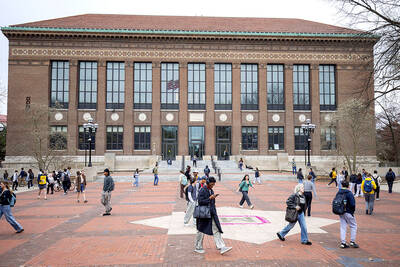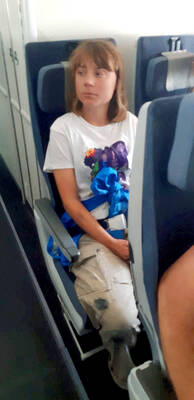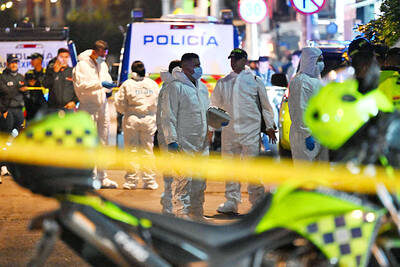Satoshi Kirishima spent almost half a century evading arrest, until mortality intervened.
As deathbed confessions go, his was astonishing: Having lived a double life as a construction worker, the 70-year-old was admitted last month to a hospital near Tokyo where he told staff he was one of Japan’s most-wanted fugitives.
In a more recent image provided to Japanese media by an acquaintance, it is just possible to discern a resemblance with the black-and-white photograph that has adorned Japanese police boxes for decades showing a bespectacled, smiling university student with shoulder-length hair.

Photo: EPA-EFE
While he shared details of his family and his organization that only he could have known, it was not until this week that DNA evidence confirmed that the terminally ill patient was Kirishima, part of a radical group responsible for a nine-month reign of terror in the mid-1970s that shook Japan.
His decision to turn himself in rekindled collective memories of a time when well-organized left-wing extremists posed a serious threat to the public, in Japan and overseas.
As a member of the sasori (scorpion) unit of the East Asia Anti-Japan Armed Front, Kirishima allegedly planted and detonated a homemade bomb that damaged a building in the Ginza neighborhood of Tokyo’s Chuo ward in April 1975. There were no casualties.
He was also suspected of involvement in four other attacks the same year targeting major Japanese corporations the group identified as “collaborators” in Japan’s militarist misadventures in the first half of the 20th century.
In the most notorious incident, the group planted a bomb at the Tokyo headquarters of Mitsubishi Heavy Industries, killing eight people and injuring more than 360 others, apparently because the firm had supplied US forces during the Vietnam war. It remained Japan’s deadliest terrorist attack until the Aum Shinikyo doomsday cult released sarin gas in the Tokyo subway in 1995.
Shortly before he died of stomach cancer late last month at the same hospital he had attended as an outpatient for about a year, Kirishima told staff: “I want to meet my death with my real name,” adding that he regretted his part in the attacks.
While police have referred the bombing cases to prosecutors, Kirishima’s death means the families of his group’s victims would never get their day in court. It has also forced investigators to establish how a high-profile criminal was able to hide in plain sight for 49 years.
In May 1975, police arrested eight people, including Masashi Daidoji, over their involvement in the attacks. He and one other were sentenced to hang, but Daidoji died of cancer in May 2017 while on death row.
Born in Hiroshima Prefecture, Kirishima attended a local school, beginning his life as a political extremist while studying law at Meiji Gakuin University in Tokyo.
His confession means it has at least been possible to form a clearer picture of what appears to have been a modest, blameless, existence during his decades on the run.
Going by the name Hiroshi Uchida, he spent about 40 years working for a building firm in Fujisawa, a city south of Tokyo. He reportedly avoided bank transactions and asked to be paid in cash to avoid leaving a paper trail that could lead to his capture. He did not have a driver’s license, cellphone or health insurance, and paid for hospital treatment out of his own pocket.
“Uchida” visited his local public bath and dropped into a bar — where he was affectionately known as “Ucchi” — to drink beer and listen to rock music, the Yomiuri Shimbun reported, adding that he shared little about himself with fellow drinkers.
Kirishima might have found closure of sorts, but the families of his victims voiced frustration that he had waited so long to unburden himself.
For one relative, whose then 23-year-old sister was killed in the Mitsubishi bombing, his mea culpa had come “too late,” he told the Yomiuri.

A Chinese scientist was arrested while arriving in the US at Detroit airport, the second case in days involving the alleged smuggling of biological material, authorities said on Monday. The scientist is accused of shipping biological material months ago to staff at a laboratory at the University of Michigan. The FBI, in a court filing, described it as material related to certain worms and requires a government permit. “The guidelines for importing biological materials into the US for research purposes are stringent, but clear, and actions like this undermine the legitimate work of other visiting scholars,” said John Nowak, who leads field

Swedish campaigner Greta Thunberg was deported from Israel yesterday, the Israeli Ministry of Foreign Affairs said, the day after the Israeli navy prevented her and a group of fellow pro-Palestinian activists from sailing to Gaza. Thunberg, 22, was put on a flight to France, the ministry said, adding that she would travel on to Sweden from there. Three other people who had been aboard the charity vessel also agreed to immediate repatriation. Eight other crew members are contesting their deportation order, Israeli rights group Adalah, which advised them, said in a statement. They are being held at a detention center ahead of a

‘THE RED LINE’: Colombian President Gustavo Petro promised a thorough probe into the attack on the senator, who had announced his presidential bid in March Colombian Senator Miguel Uribe Turbay, a possible candidate in the country’s presidential election next year, was shot and wounded at a campaign rally in Bogota on Saturday, authorities said. His conservative Democratic Center party released a statement calling it “an unacceptable act of violence.” The attack took place in a park in the Fontibon neighborhood when armed assailants shot him from behind, said the right-wing Democratic Center, which was the party of former Colombian president Alvaro Uribe. The men are not related. Images circulating on social media showed Uribe Turbay, 39, covered in blood being held by several people. The Santa Fe Foundation

NUCLEAR WARNING: Elites are carelessly fomenting fear and tensions between nuclear powers, perhaps because they have access to shelters, Tulsi Gabbard said After a trip to Hiroshima, US Director of National Intelligence Tulsi Gabbard on Tuesday warned that “warmongers” were pushing the world to the brink of nuclear war. Gabbard did not specify her concerns. Gabbard posted on social media a video of grisly footage from the world’s first nuclear attack and of her staring reflectively at the Hiroshima Peace Memorial. On Aug. 6, 1945, the US obliterated Hiroshima, killing 140,000 people in the explosion and by the end of the year from the uranium bomb’s effects. Three days later, a US plane dropped a plutonium bomb on Nagasaki, leaving abut 74,000 people dead by the